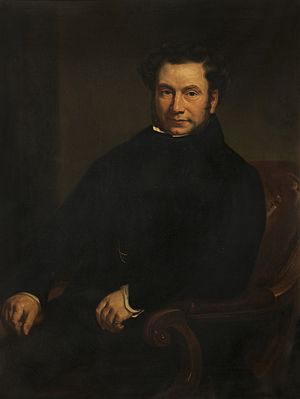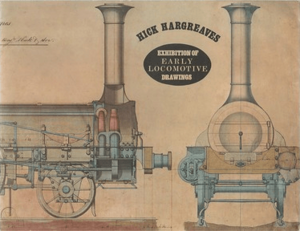B. Hick and Sons facts for kids
 |
|
| General partnership | |
| Industry | Engineering Heavy industry |
| Predecessor | B. Hick and Son |
| Successor | Hick, Hargreaves & Co. Ltd. |
| Founded | 10 April 1833 |
| Founder | Benjamin Hick |
| Headquarters | Soho Iron Works, Crook Street, , United Kingdom
|
|
Number of locations
|
2 |
|
Key people
|
John Hargreaves Jr John Hick George Henry Corliss William Hick William Hargreaves William Inglis Robert Luthy Benjamin Hick John Henry Hargreaves Wyndham D'arcy Madden George Arrowsmith |
|
Number of employees
|
|
Hick, Hargreaves & Co. was a British engineering company located in Bolton, England. It started in 1833 as B. Hick and Sons. The founder, Benjamin Hick, began the company with his two sons, John and Benjamin Jr. This company became famous for making powerful steam engines and other important machinery.
Contents
Building Early Locomotives
Hick, Hargreaves & Co. built its first steam locomotive in 1833. It was called Soho, named after their factory. This train was made for carrying goods.
In 1834, they designed a special four-wheeled train car. It was one of the first trains with three cylinders. This design helped make trains more efficient.
Trains for the World
Over the 1830s, the company built more locomotives. Some of these trains were sent to the United States. For example, they sent trains to the Pontchartrain Railroad and the St. Charles Streetcar Line in New Orleans.
Between 1837 and 1840, they also helped other companies build engines. Their trains were used on many important railway lines in Britain. These included the Midland Counties Railway and the London and Birmingham Railway. They even built trains for lines in France.
In 1841, Hick built three locomotives similar to American designs. These were used on a very steep railway section called the Lickey Incline. The company continued to build different types of locomotives until 1855.
Amazing Wheel Designs
Benjamin Hick also designed a special type of wheel. These were called "disc wheels" and were used on some Great Western Railway trains. One of these trains, nicknamed Grasshopper, was an experimental prototype. It might have been the world's first streamlined locomotive.
These disc wheels were also used for other purposes. Large 10-foot disc wheels from two locomotives helped move a huge statue of the Duke of Wellington to Hyde Park Corner in London.
Today, disc wheels and similar designs are used in many areas. You can find them on armored cars, drag racing vehicles, and bicycle racing bikes. They help these vehicles move faster by reducing air resistance.
Detailed Engineering Drawings
The company's collection of early engineering drawings is very special. Many of these drawings were made by Benjamin Hick and his son John between 1833 and 1855. They show amazing technical detail and artistic skill.
These drawings were not just for building machines. They were also beautiful works of art. They influenced how science and technology were shown to the public at the time. Today, these important drawings are kept in archives in Bolton and at the University of Surrey.
Hick, Hargreaves & Co. Evolves
After Benjamin Hick passed away in 1842, his eldest son, John Hick, took over the company. It was still called Benjamin Hick & Son.
In 1845, John Hick brought his brother-in-law, John Hargreaves Jr, into the business. Later, William Hargreaves, another brother-in-law, also joined. This is how the company got the name Hick, Hargreaves & Co.
Exhibiting Great Inventions
In 1851, B. Hick and Son showed off their amazing machines at The Great Exhibition in London. They displayed steam engines and other factory equipment. They even won an award for their "mill gearing" and other tools.
One of their models, a 1:10 scale model of a large steam engine, is now at the Science Museum. It shows how advanced their engineering was. Another model, a three-cylinder locomotive, is on display at Bolton Museum.
Beyond Locomotives
While they built many locomotives, the company focused more on other types of engines. They made many marine (ship) engines and stationary engines for factories.
They supplied engines for important ships, including the Brazilian Navy's frigates Dom Afonso and Amazonas. These ships were involved in historical battles.
The company also made machinery for many other industries. They built blowing engines for furnaces, boilers, and equipment for paper mills. In 1856, they supplied machinery for a paper mill at Woolwich Arsenal. This mill made cartridge bags for the entire British army and navy.
New Technologies and Growth
In 1863, Hick, Hargreaves & Co. started making steel boilers. They also introduced the very efficient Corliss valve gear to the United Kingdom around 1864. This technology came from the United States and made steam engines much better.
By 1881, they were building some of the largest cotton mill engines in the world. They even won a Gold Medal at the 1885 International Inventions Exhibition for their products.
The company was officially renamed Hick, Hargreaves and Company in 1867. John Hick retired in 1868 to become a member of parliament (MP). The business became a private limited company in 1892.
Expanding into New Areas
Around 1885, Hick Hargreaves & Co. started making steam engines for power stations. They built engines for the Deptford Power Station, which was the largest power station in the world at that time.
During World War I, the company helped with war efforts. They produced shells, mines, and marine oil engines for submarines. Their special gear for guns was so successful that a large part of their factory was used to make it.
After the war, the company looked for new markets. They started making parts for cars and large diesel engines. They also began making equipment for high vacuum systems, which became very important for power generation.
Modernizing and Specializing
In the 1920s, the company focused on making steam turbines for electricity generating stations. They became a major supplier to the Central Electricity Board (CEB), which managed electricity in Britain.
During the 1930s, Hick Hargreaves & Co. bought the designs and records from other steam engine makers that had closed down. This allowed them to make money by repairing old engines and supplying spare parts, even during the Great Depression.
After World War II, the company continued to grow. They expanded into food processing, oil refining, and offshore oil equipment. They also supplied vacuum pumps for important projects, like a special chamber built to study high-speed flight.
By the 1960s, Hick Hargreaves was involved in nuclear energy. They supplied equipment for early atomic power stations in the UK and even for Japan's first atomic power station.
In 2000, the company's products included compressors, blowers, refrigeration equipment, and vacuum ejectors.
Soho Iron Works Community
The Soho Iron Works was not just a factory. Between the 1840s and 1870s, the firm had its own Brass Band. It was known as the Soho Iron Works Band. The band would play music through the streets of Bolton, wearing special uniforms.
Changes in Ownership
In 1968, the Hargreaves family sold their shares in the company. Hick, Hargreaves & Co. became part of larger groups, eventually joining Smiths Group.
In 2002, Smiths Group sold the Soho Iron Works factory. The factory closed down after 170 years of operation. Some of the old equipment and records were saved and moved to museums and archives.
In 2001, BOC bought the business from Smiths Group. The offices were moved, and some manufacturing equipment was sent to another country.
Mills Using Hick, Hargreaves Engines
Many textile mills relied on powerful engines made by Hick, Hargreaves & Co. Some examples include:
- Textile Mill, Chadderton
- Cavendish Mill, Ashton-under-Lyne
- Century Mill, Farnworth
- Pioneer Mill, Radcliffe
Images for kids
-
Gold Medal certificate awarded to Hick, Hargreaves and Co. at the International Inventions Exhibition 1885 for their Corliss engine supplementary governor & automatic barring engine. signed by the Prince of Wales and Frederick Bramwell.
-
Hick Hargreaves & Co. smiths and strikers with a forman 1888. An anvil and crankshaft in the foreground.
-
Under assembly c.1890, half of one of the two 10,000 hp engines completed for Deptford Power Station at Hick, Hargreaves and Co. A travelling crane and hoist above.
-
Finishing the ends of a crankshaft after building; an improvised lathe for machining a large steam engine crankshaft, 1900 with a worm and wheel for turning the shaft in the centre. In the background on the far right is a screw cutting machine.
-
Flywheel for a large textile mill engine 1900, set up to machine grooves for the rope drives simultaneously. The saddle with two tool posts to the front. The wheel is rotated by two pinions driving via the cast-in barring gear teeth in the flywheel rim. Temporary wedges are securing the spokes to the hub of the wheel. A travelling crane behind and above.
-
Flywheel for a large rolling mill engine 1900; the heavy rim is cast in four sections bolted together at the rim. Top right, the trunk guide and bedplate of the engine under manufacture, beyond the bedplate is the flywheel and connecting rod of a small horizontal steam engine.
-
Flywheel; the hub and spokes cast in two halves, bolted at the hub with the rim assembled from ten castings. These are bolted to the spokes, held together by shrinking rings in the grooves.
-
Small steam hammer 1900, with line shafting and belt drives to the rear.
-
Superheater of a Lancashire boiler 1900, for the extraction of heat from waste gasses, and transfer of heat to saturated steam passing from the boiler to the steam range or engine. This raised the overall thermal efficiency of the plant, and would also prevent damage from slugs of condensate by ensuring the saturated steam was dry and not wet.
-
From The Engineer, a 400 hp 4-cylinder Hick Hargreaves & Co. Ltd. stationary Diesel engine under test, destined for Guayaquil, South America, 1920.
-
Certificate issued by The Ministry of Labour for The National Scheme for the Employment of Disabled Men, recognising the membership of Hick Hargreaves and Co. Ltd. Signed by Thomas James Macnamara, Minister of Labour 1920–1922.





















